An easy cheese pupusas recipe using only a few basic ingredients. This step-by-step tutorial is fun for the whole family and results in perfectly crispy flatbread stuffed with molten cheddar cheese. This simple recipe is very similar to pupusas.
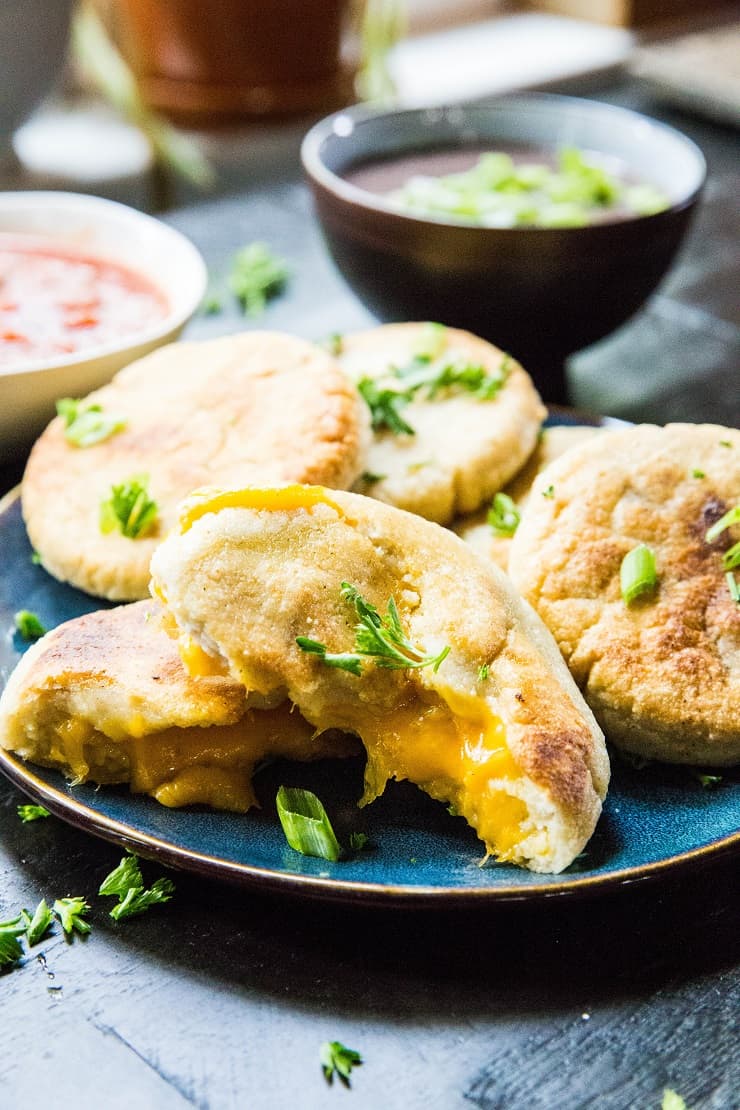
My original approach to this recipe was to create a spin on classic pupusas. Authentic pupusas includes white onion, mashed red beans (such as kidney beans) and queso Oaxaca.
If you love anything bread-like, crispy, and/or molten cheesy, chances are you will LOVE this crispy cheesy flatbread.
It is all-things crispy on the outside, soft on the inside, and stuffed with molten cheddar cheese for the ultimate gooey adventure. This palate-pleasing flatbread is naturally gluten-free as it is made with masa harina (corn flour).
All you need is a few basic ingredients: masa harina, some form of cooking oil (I use avocado oil), some spices from the pantry (I use cumin and paprika), and some form of cheese (I use cheddar).
Making this gluten-free cheese flatbread at home may seem daunting, but I can assure you the process is easy! And fun!
This easy, step-by-step tutorial brings inspiration to prepare this gluten-free cheese flatbread at home.
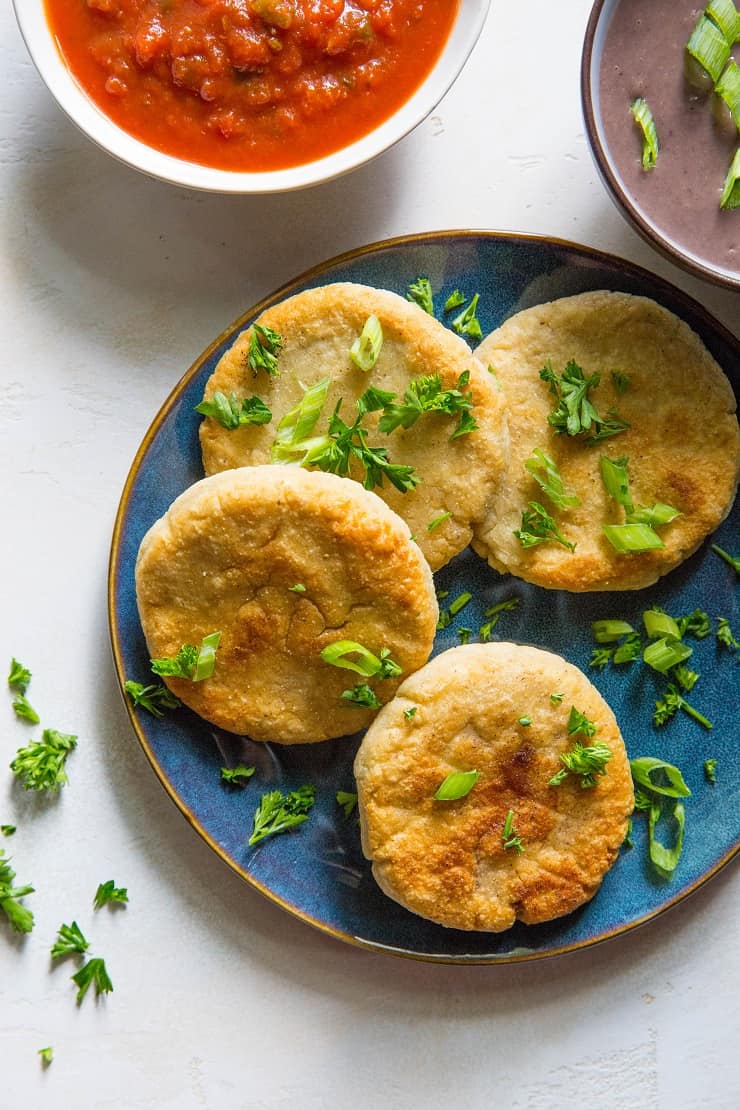
How to Make Cheese Pupusas
Add the dry ingredients (masa corn flour, ground cumin, paprika, and sea salt) to a stand mixer fitted with a paddle attachment and mix on low speed until combined.
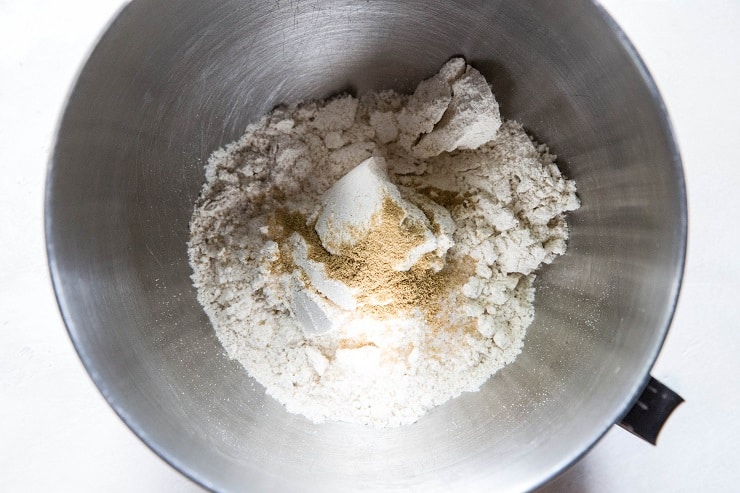
Add the hot water and beat until a thick dough forms.
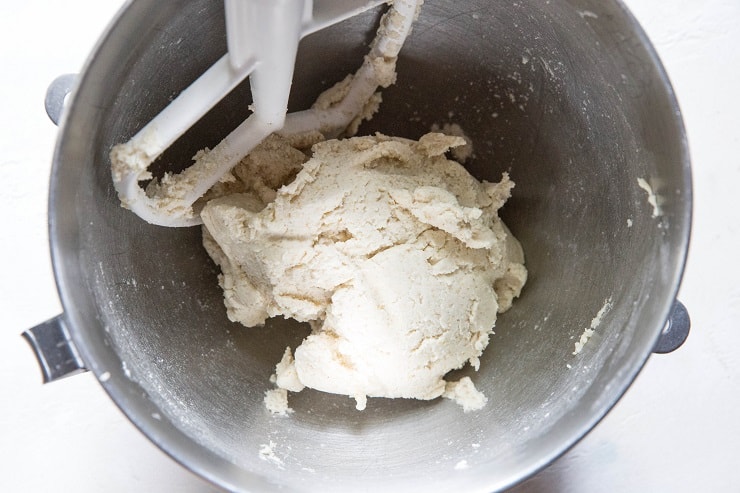
Use your hands to form the dough into a large ball and place back in the mixer bowl. Cover with a damp towel and allow dough to sit 15 to 20 minutes.
Divide the dough into 6 to 8 portions (depending upon the size of flatbread you’re aiming for). Roll each portion into a ball.
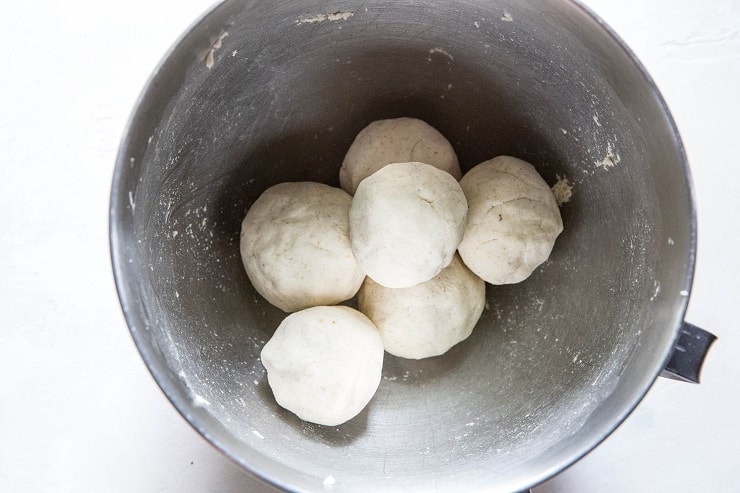
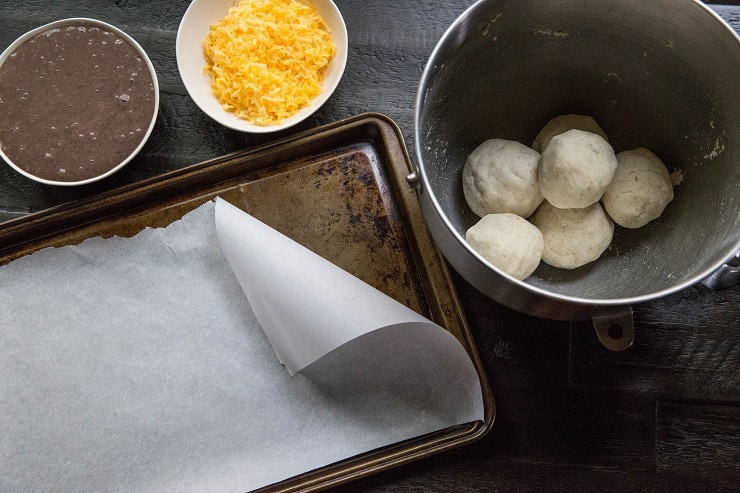
Press the dough to form a well. It should look like a small bowl with thick sides. Fill the well with 2 to 3 tablespoons of grated cheese.
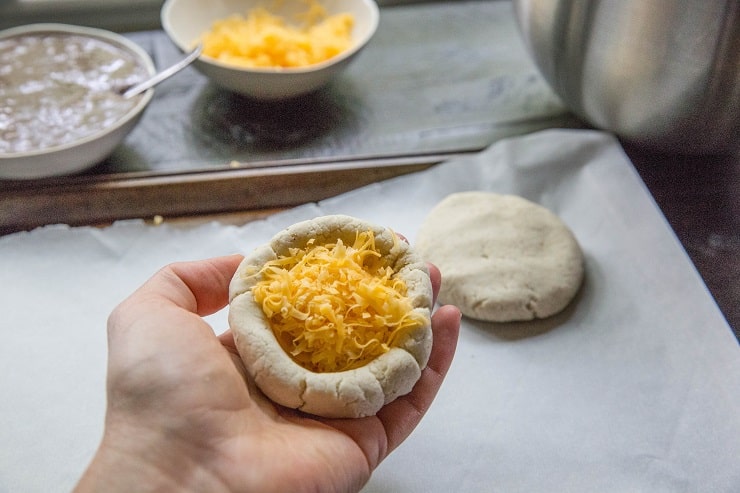
Press the cheese down into the well to compress it and make it easier to fold the dough over the top.
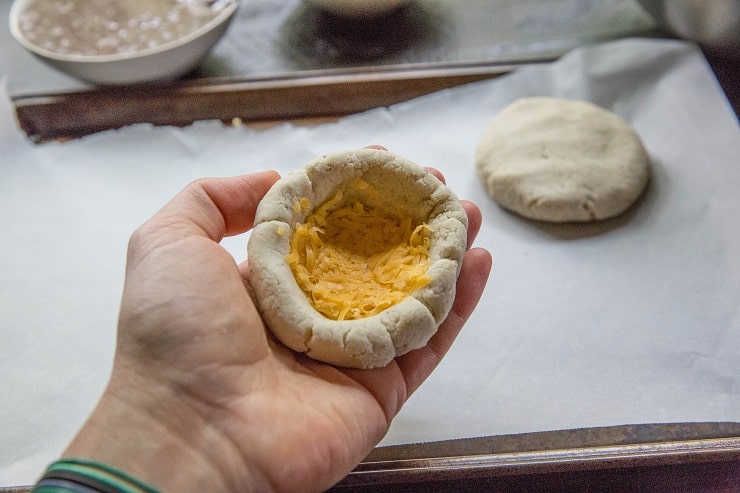
Using both hands, fold the corners of the dough over the cheese filling. Keep pressing together until you have a ball of dough and the cheese filling is entirely enclosed.
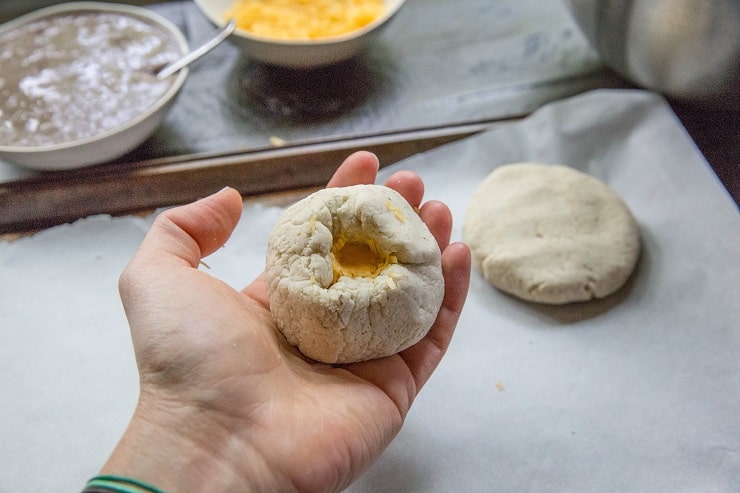
Press the dough into a disc, about 4 1/2 to 5 inches wide.
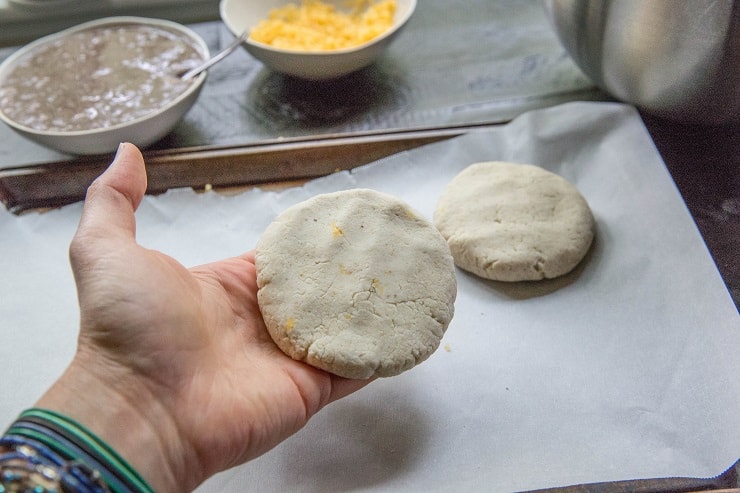
Place the discs onto a plate or cookie sheet, and repeat for remaining dough.
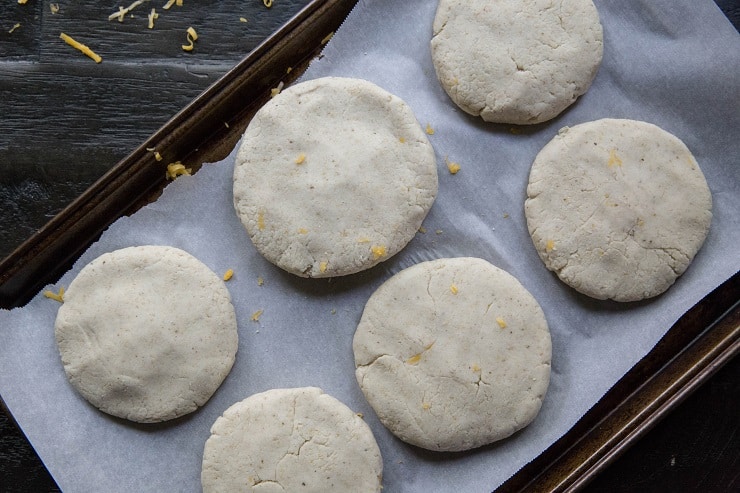
Heat 2 to 4 tablespoons of avocado oil or high-temperature cooking oil of choice (algae oil works great because it has a very high smoke point!) in a large cast iron skillet over medium heat.
Once the skillet is completely hot, carefully place two to three flatbreads on the hot surface. Cook 2 to 3 minutes, until golden-brown and crispy. Carefully flip, then cook another 2 to 3 minutes until flatbreads are cooked through and both sides are crispy.
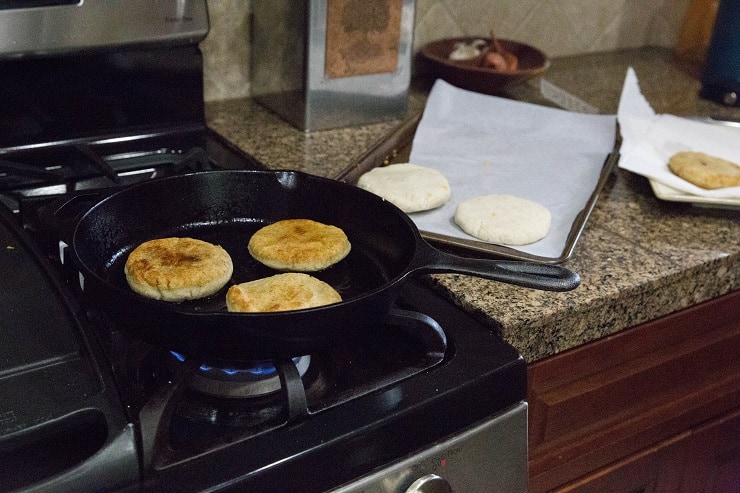
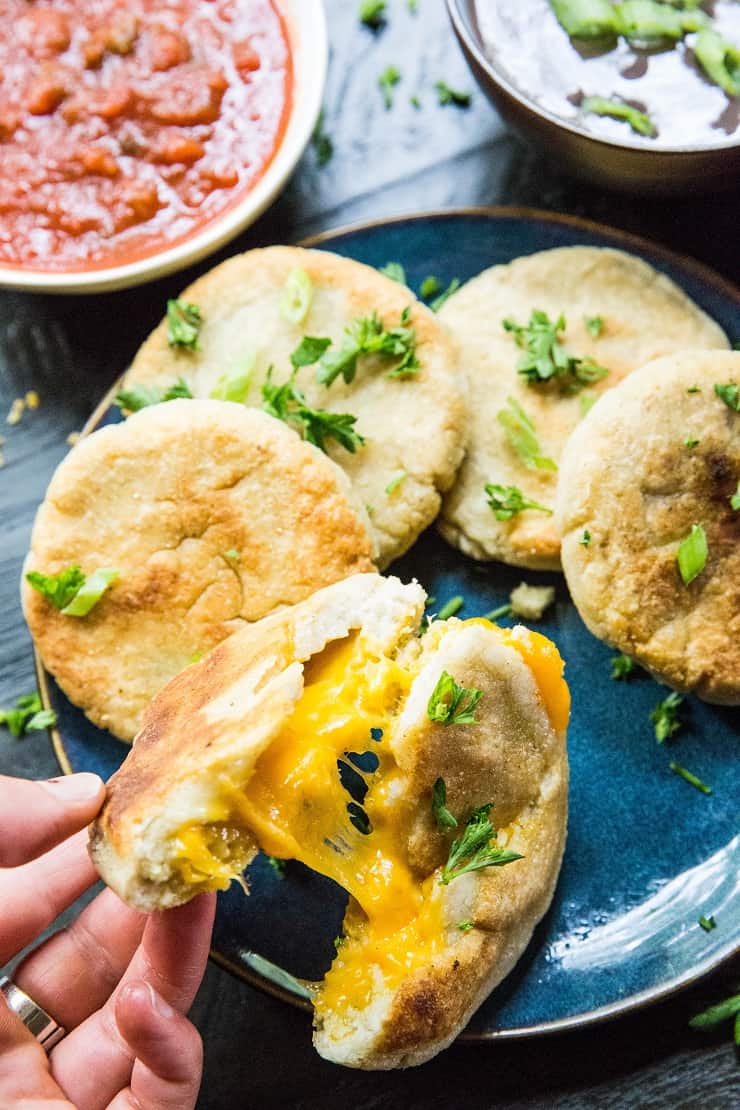
Serve pupusas with choice of salsa, sauce, and/or bean dip!
Recipe Adaptations:
- Change up the cheese: Use grated queso Oaxaca, crumbled queso fresco/cotija cheese. You can also go with jack cheese or mozzarella cheese instead of cheddar. You can also use multiple types of cheese!
- Add Beans: Add 2 Tbsp mashed red beans or refried black beans to the center of the flatbread for a bean and cheese version.
- Incorporate Meat: Use shredded chicken, pork, or beef for a meat lover’s flatbread.
- While there is typically room to adapt most recipes, there isn’t much you can do in this situation other than changing up the filling. The bulk of the recipe is the masa flour, which should not be replaced with anything else.
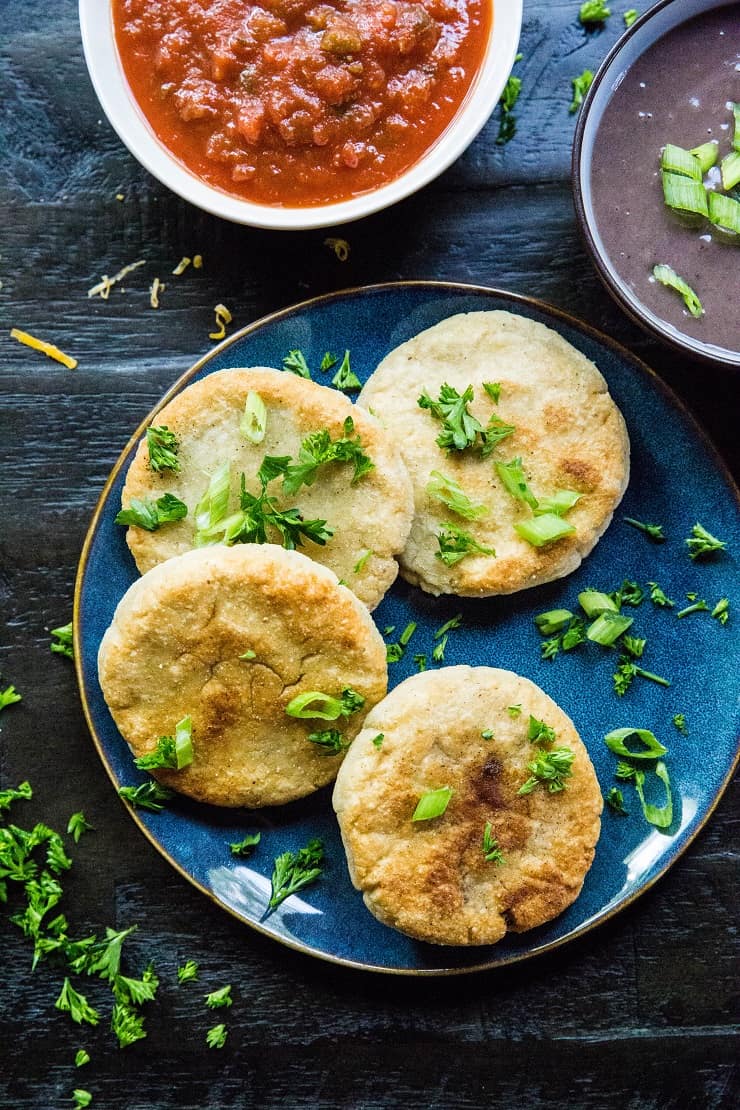
What Type of Flour to Use:
In order to make this recipe, you need finely ground golden masa harina corn flour. You can find masa harina corn flour at most grocery stores. I like using Organic Masa Harina Corn Flour, which you can find online or at select natural food stores.
You May Also Love:
- Instant Pot Shredded Mexican Beef
- Instant Pot Carnitas
- Naturally Sweetened Horchata
- Small Batch Sweet Potato and Black Bean Enchiladas
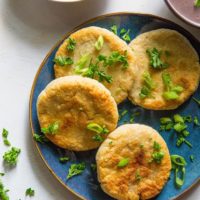
Cheese Pupusas
Ingredients
- 2 cups masa harina corn flour
- 1 tsp ground cumin
- 1/2 tsp paprika optional
- 3/4 tsp sea salt
- 1 1/2 cups warm water
- 2 cups grated cheddar cheese or cheese of choice
- 3 Tbsp avocado oil for cooking
Instructions
- Add the dry ingredients (masa corn flour, ground cumin, paprika, and sea salt) to a stand mixer fitted with a paddle attachment and mix on low speed until combined. Add the hot water and beat until a thick dough forms.
- Use your hands to form the dough into a large ball and place back in the mixer bowl. Cover with a damp towel and allow dough to sit 15 to 20 minutes.
- Divide the dough into 6 to 8 portions (depending upon the size of papusa you’re aiming for). Roll each portion into a ball.
- Press the dough to form a well. It should look like a small bowl with thick sides.
- Fill the well with 2 to 3 tablespoons of grated cheese. Press the cheese down into the well to compress it and make it easier to fold the dough over the top.
- Using both hands, fold the corners of the pupusa dough over the cheese filling. Keep pressing together until you have a ball of dough and the cheese filling is entirely enclosed.
- Press the dough into a disc, about 4 1/2 to 5 inches in diameter. Place the discs onto a plate or cookie sheet, and repeat for remaining dough.
- Heat 2 to 4 tablespoons of avocado oil or high-temperature cooking oil of choice (algae oil works great if you have it because it has a very high smoke point!) in a large cast iron skillet over medium heat.
- Once the skillet is completely hot, carefully place two to three papusas on the hot surface. Cook 2 to 3 minutes, until golden-brown and crispy. Carefully flip, then cook another 2 to 3 minutes until papusas are cooked through and both sides are crispy.
- Serve pupusas with choice of salsa, sauce, and/or bean dip!

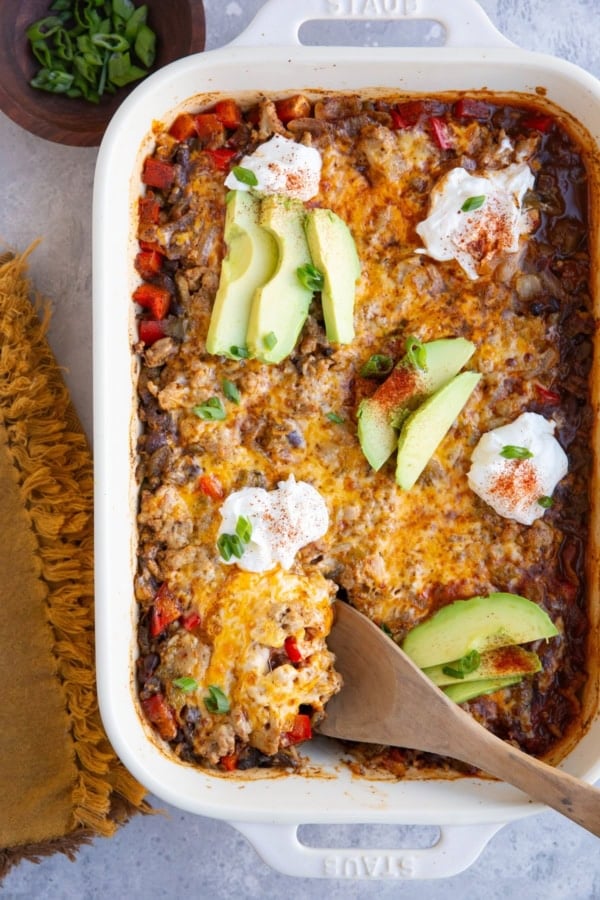
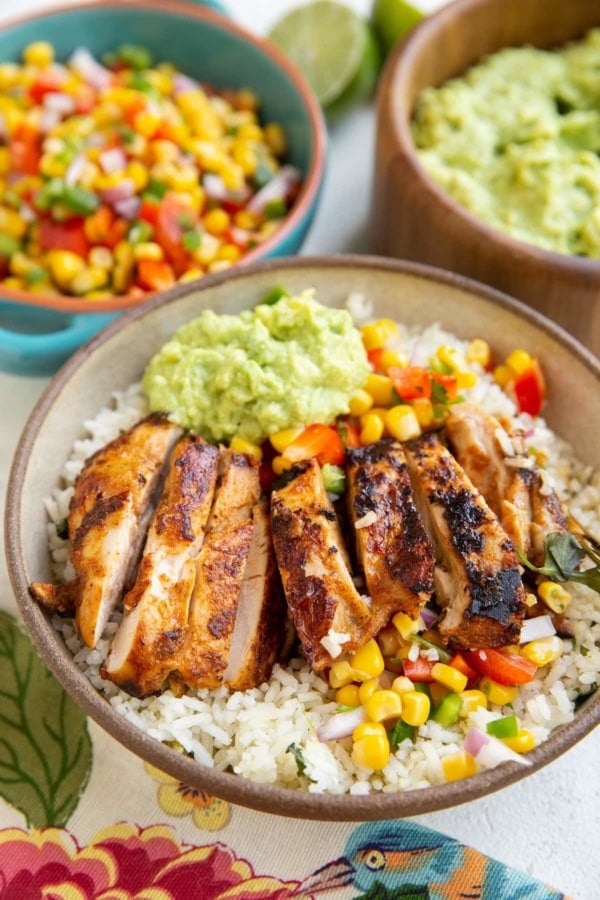
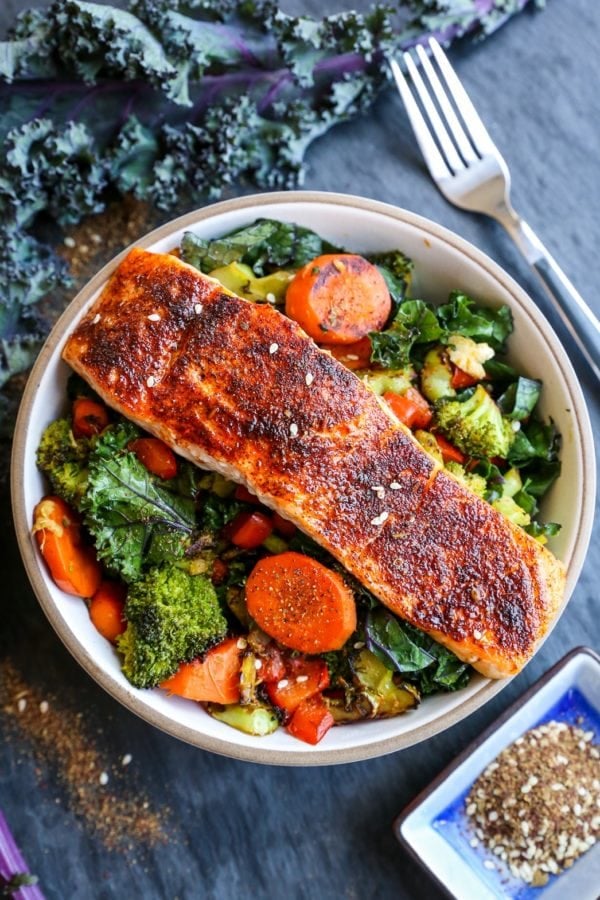
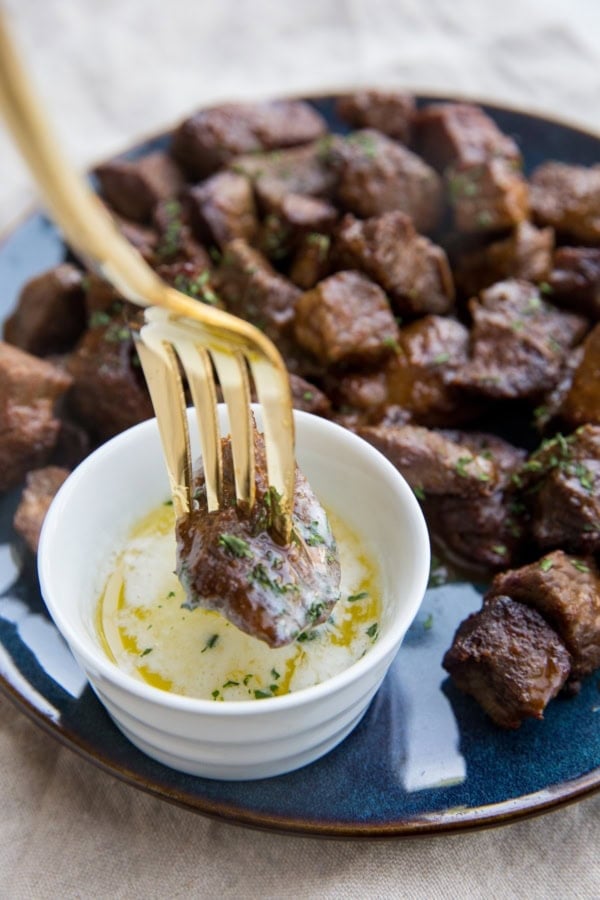









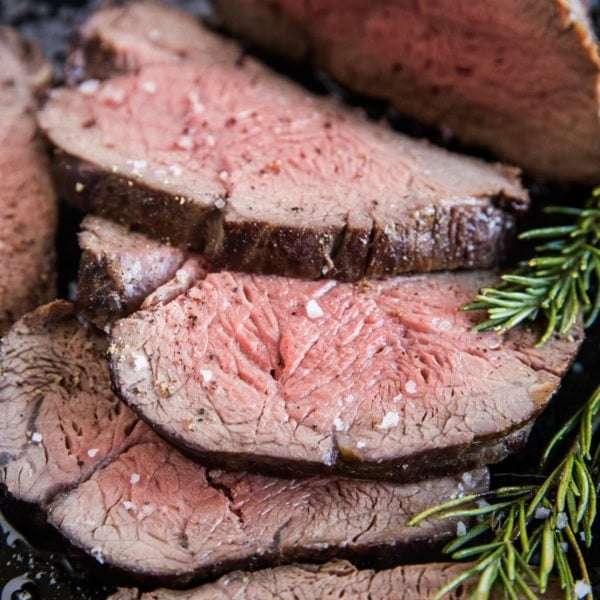
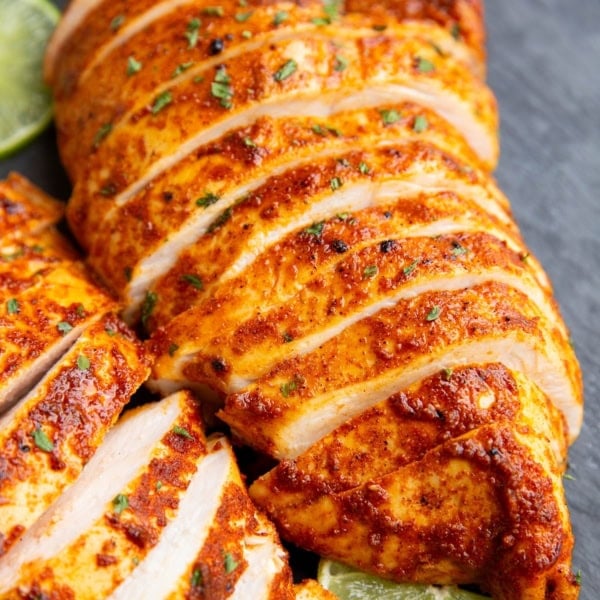
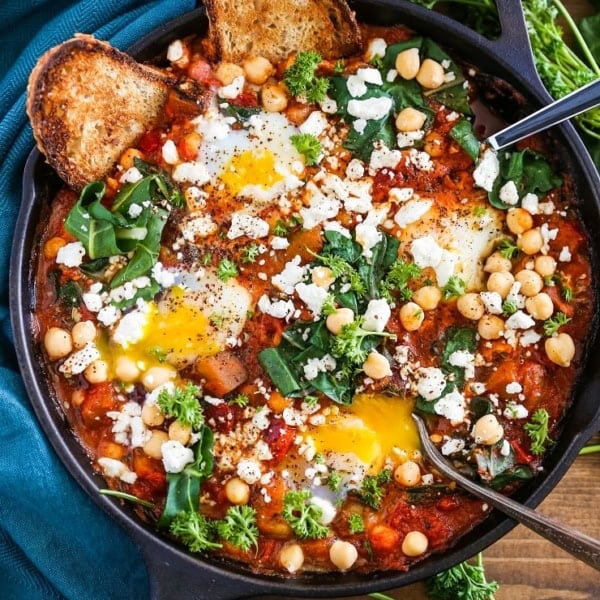
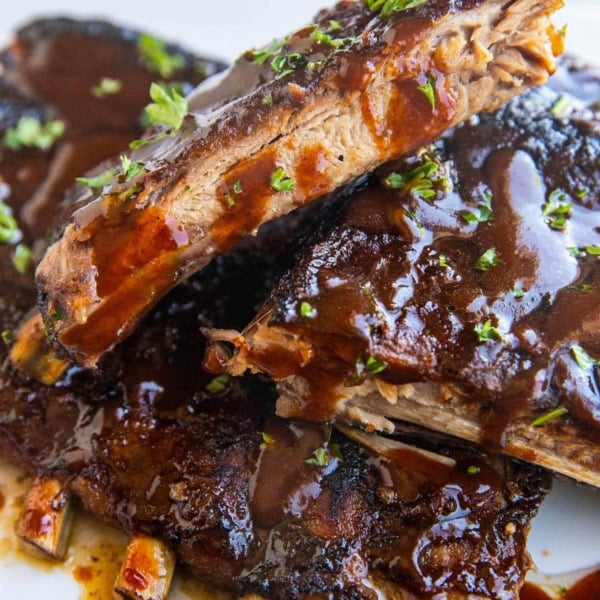
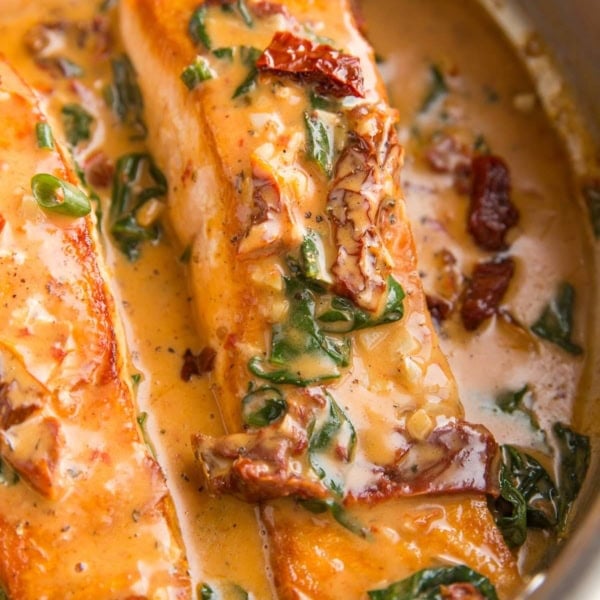
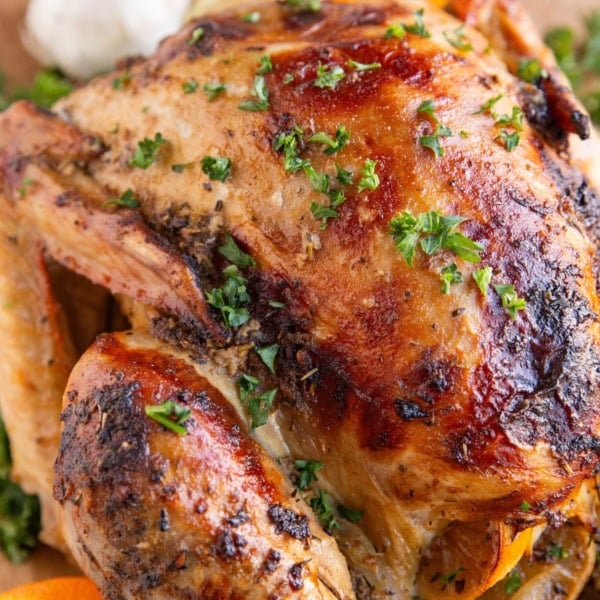
Thank you for a great idea to add to my rotation of easy, delicious accompaniments for the Central America cuisine. Flavor and spice are big around our table.
Question can I use a keto flour to make these?
Hi Sarah! I haven’t tested the recipe using keto flour. My guess is it will work just fine as long as you’ve had success with a similar recipe in the past. My only concern would be whether or not the flour would hold together when handling it. If you’ve made other dough-like recipes, it should work great 😉 Hope this helps!
I love Pupusas… and the Curtido that is served along with the red salsa… this recipe from Mexican Please looks close to what the Salvadorian restaurant here serves.
Ingredients
1/2 head green cabbage
1 carrot
1/2 onion
1/2 jalapeno
1 cup vinegar
1.5 cups water
1 teaspoon Mexican oregano
freshly cracked black pepper
2 teaspoons salt (Kosher or sea salt)
Instructions
Thinly slice the 1/2 head of cabbage, 1/2 onion and 1/2 jalapeno. Grate the carrot.
Combine the remaining ingredients in a bowl: 1 cup vinegar, 1.5 cups water, 1 teaspoon Mexican oregano, freshly cracked black pepper, 2 teaspoons salt (Kosher or sea salt).
Add the liquid mixture to the veggies and combine well. Crush the cabbage a bit so that it will fit into the jars.
Fill two pint-sized Mason jars with the veggies and top with the brine.
Seal well and let pickle overnight in the fridge.
Notes
Kosher or pure sea salt are most commonly used for pickling. The additives in iodized salt will sometimes affect the brine so it isn’t recommended.
Using a half jalapeno still creates some real heat even though it doesn’t sound like much. You can always dial back and use less (or none) if you want a milder version.
If you don’t have Mexican oregano you can simply omit the oregano.
A non-reactive container is best to house the vinegar brine, with glass being the preferred choice.
Hi Julia,
Thank you so much for sharing!
I’m very sorry for the people who might get “offended” because is not the real deal. However, u made it clear this isn’t the traditional dish.
U know, I’m soooo so happy as a Salvadoran that you’re posting this. So glad that u give your approach and your own version of this “cheesy flatbed” xD otherwise known as pupusas xD they look so good and look just like a pupusa de queso (cheese pupusa). How cool u even made the sauce.
U know, even back home people tries making then with different nontraditional ingredients which come up great.
sure this is something I’ll try myself!
Hi David,
I could hug you right now! Thank you so much for the support! This was a big lesson for me in blogging…just when you think you’ve experienced it all, right?! I very much appreciate you taking the time to provide a level-headed perspective, and I hope you have a wonderful weekend! Much love to you, my friend! xoxox
Any chance the water measurements is too high? I’ve worked with mass before and it’s practically soupy…?
Oh man..It should be 1 1/2 cups of water, not 2 1/2. If you’ve already started, you can add 1 more cup of masa harina, in which case you’ll end up with a larger batch of flatbread. You may also need to add a couple tablespoons of water if it’s too dry after adding the third cup. My apologies!! I hope they turn out amazing! xoxo
I ?appreciate your tact in your responses to all of the above! ?
Thank you lady…I really appreciate that! 😀 I wasn’t sure how to navigate the situation. I completely understand that if someone is just happening upon my site and doesn’t know my character that misinformation could be offensive. Everyone who knows me knows I would never intentionally spread incorrect information and have zero bad intentions in sharing my content. Anyway, I hope my changes to the post have dissolved any frustration…it truly is a delicious recipe. Thanks so much for your support…that really helped calm my soul! xoxox
Q barbaridad!
Cómo pudieron arruinar un platillo tradicional de El Salvador con esta receta utilizando ingredientes q ofenden a las Pupusas.
Cuando quieran publicar algo de otra cultura deberían de informarse primero para q el mundo q lee no agarre recetas equivocadas y q arruinan y ofenden a un platillo tan típico…
Nada de lo publicado es cierto… Empezando por la harina, el queso, no paprika…. Mejor ya no sigo….
Cómo Salvadoreña me siento ofendida!!!
Please refer to the previous comments.
I’m agreed with Mariajose Alcantara real name is pupusas and they are thinner not too tick,
They are soo delicious and origin is from El Salvador not Honduras.
Hi Evelyn,
My apologies I didn’t make them as thin as they are traditionally made. I was relying on internet research when discussing the origin, and I found several articles saying pupusas are traditional in Honduras as well as El Salvador. Nevertheless, I have made the change. Let me know if you notice anything else that is incorrect.
These sound amazing. We are doing unleavened bread all week so I’m going to give these a go! I have shredded chicken ready and I’ll probably throw in some refried beans bc my kiddos love them. Thanks for the idea!!
Ooh, I love that idea, Lauri! Let me know how they turn out! xoxo
Hi I don’t want to disrespect you but papuchas salvadoreñas are made with homemade maseca cheese beans chicharron and on the side hot sauce homemade add homemade cortido and everybody that is from my country Salvador can let you know that that’s the way you do want a hundred percent those are invitations and that’s the way you could come but that’s not the way people from Salvador cook them hola no quiero faltarle el respeto si le quiero decir que las popusas salvadoreñas no se hacen a esa manera se hacen con maseca después con chicharrón frijoles y queso después va con salsa y después con cortido así nace cocinera en mi país El Salvador if you like my message give me a thumbs up??? El Salvador?? United States I send out everybody prayers that are going through hard times because of the Coronavirus sending out my love from Hilliard Ohio????
Hi I’m made a mistake by saying papuchas but what I meant that you make the pupusa salvadoreñas and I made a mistake by saying popusa I made a mistake by spelling it like that but it I meant the word pupusa salvadorena I just wanted to correct that issue sorry for the mistake of the spelling
Hi Beatrice,
No problem at all..we all make mistakes 😀 My apologies for any confusion my post caused. I added to it to clarify that this is not the traditional version. Hope you stay well! xoxo
Hello sorry this is no the name the name is pupusa an the recip is no the pupusas salvadorans
Hi Yuly,
My sincere apologies – I made corrections to the post to indicate that this is not a traditional Salvadoran recipe, but a different version. Thank you for the note! xoxo
My store only carries the instant kind of masa harina, will that still work in this recipe?
Hi Cindy!
Yes! That’s exactly what you want! Hope you love them!
First of all, great attempt, however, please revise the post to the correct name of the traditional Salvadorean food, PUPUSAS, not PApusas. But since your rendition is nothing like the actual thing, I guess you’ve invented a whole new meal, the PAPUSA. Salvadoreans never mix their masa with a stand mixer, it must be done by hand, nor does it contain paprika, cumin, and they are never made with cheddar cheese. I don’t post this comment to harm you, I post it so our traditional recipe is not disrespected, butchered nor culturally appropriated. You’re welcome to try again and do it right. But please for the love of food, they’re not called PAPUSAS.
Hi Mariajose,
I apologize sincerely for any frustration I caused. I didn’t mean to slaughter a beautiful traditional dish. I have a great deal of respect for all cultures and the last thing I would want to do is propagate misinformation about any country’s cuisine.
I made corrections to my post to fix the spelling (I feel awful about that…), and to indicate that this is not the traditional approach to pupusas, but a different spin on it. My intention was to provide a different spin, as anyone can google a traditional recipe for pupusas and come up with the same one every time. I simply wanted to inject a different method that could be approachable for those who have a difficult time finding the traditional cheese. I would feel the same as you if I thought someone was spreading inaccurate information about a dish I held dearly.
In any event, I do want to assure you that while my recipe is not 100% traditional, it is pretty tasty! If you see anything else in my post you think needs updating, please feel free to let me know. I should have been more clear at the onset that I was taking creative liberties, and will be more careful in the future when discussing a dish that is not of U.S. origin. I hope you stay well and thank you for taking the time to contribute your knowledge. xoxox
What a fun recipe. Do you think this is easy enough for pre-tens to make?
I think so! They probably just need to be shown once and then it will be easy peasy for them. xo